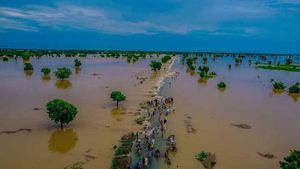Wildfires have been a significant menace across Colorado and the Western United States, with increasing frequency and intensity noted over the years. The environmental changes driven by climate change have made this summer particularly severe, propelling the need for innovative solutions to monitor, track, and fight these flames. Experts are turning to artificial intelligence (AI) as one of the new tools for tackling this persistent problem.
According to the National Oceanic and Atmospheric Administration (NOAA), traditional methods of tracking wildfires are becoming increasingly inadequate due to the scale and intensity of modern fire seasons. "There simply aren’t enough boots on the ground, or eyes in pairs of binoculars to cover the base and the extent of what we’ve been dealing with," said Sarvesh Garimella, the chief scientist at MyRadar. With hotter, drier summers attributed to climate change, the challenge of managing wildfires is only growing.
The Environmental Protection Agency (EPA) reports suggest a marked increase in the number and reach of wildfires over the past few decades. Data indicates the land impacted by wildfires has grown dramatically, from just 5% to 22% between 1981 and 2021. "Wildfires are now more common and spread farther than ever before," the EPA outlined. Climate cycles have shifted, creating warmer and drier conditions, making the region ripe for wildfires.
Predominantly, human activities account for nearly 90% of all wildfires—careless actions such as improperly extinguished campfires and discarded cigarettes are major contributors. This summer has seen alarming fire statistics, with the activity level already surpassing the average for the last decade. For example, firefighters tackled what was then the largest fire of 2024, which consumed around 270,000 acres across Oregon, leading to evacuation warnings for nearby residents. At the same time, Colorado faced grave challenges with multiple fire outbreaks, with one tragic blaze claiming lives along the Front Range.
Part of the momentum shifting toward AI is driven by its ability to process massive amounts of data quickly. The cornerstone of many AI models is to analyze and interpret data, something critical for fire detection and response. NOAA’s Next Generation Fire System is leading the charge; this AI system leverages satellite imagery and historical wildfire data to identify emerging threats. NOAA’s satellites can capture images every 30 seconds, enabling real-time monitoring.
The AI technology analyzes these images to detect heat patterns, alerting emergency response teams more efficiently than human observers could. This system is particularly significant for rural areas, which may not have the same level of surveillance as urban regions. "Getting to the fire when it’s small increases the chances of successfully extinguishing it," explained Zach Tolby, director at NOAA’s fire weather testbed.
Similarly, the University of Southern California is exploring AI through their predictive models, utilizing the conditional Wasserstein Generative Adversarial Network (cWGAN). This model draws on past fire data and satellite images to predict how fires may spread. By simulating wildfire scenarios based on real incidents, researchers can estimate future behavior, enabling proactive interventions.
Garimella notes how the incorporation of AI technologies has transformed the climate science field. His app, MyRadar, which provides advanced weather information and alerts, recently developed the Orbital Wildfire Resilience solution, selected for advancement within the XPRIZE wildfire competition. This highlights the growing emphasis on using satellites fitted with AI to improve response times and effectiveness during wildfire outbreaks.
Notably, autonomous drones are also becoming central to firefighting strategies. Equipped with cameras, these unmanned aerial vehicles can gather critical information about fire conditions, allowing emergency responders to make informed decisions more swiftly. Public safety technology firms, like BRINC, have begun deploying drones for immediate fire assessments, drastically cutting down reaction times.
While the advent of AI technologies seems promising, experts argue these innovations must complement experienced human oversight. Reliable response relies not just on technology but also on the nuanced decision-making capabilities of trained personnel. The collaboration between scientists, emergency responders, and technology developers is key to enhancing firefighting strategies moving forward.
Colorado's recent wildfires, such as the Bucktail fire which recently doubled to over 7,200 acres, showcase the seriousness of the wildfire threat. Initially ignited on August 1 near Nucla, the fire spread swiftly to forested regions, raising containment concerns. Firefighters continue to work diligently to contain the blaze, currently at just 10% containment. It is critical to underscore the distinction between containment and safety; the challenge remains pronounced for those living near these wildfires.
Despite the ever-growing difficulties surrounding wildfire management, the push for improved technology—especially adopting AI—provides hope. The evolution of firefighting tactics aligns not only with the urgent need for better efficiency but also with the necessity to keep communities safe. Experts stress the importance of viewing these AI technologies as just another powerful tool within the broader context of wildfire management and education for public safety.



